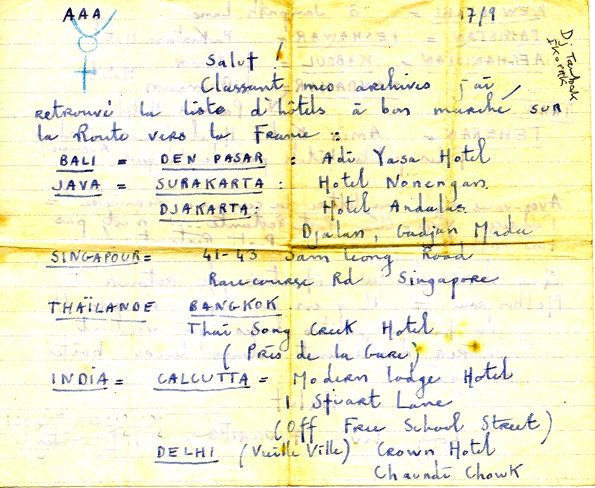
Chez les Bâtisseurs d'utopies
d' Emmanuel-Yves Monin :
Notes, Images et textes complémentaires
Pour la "Route des Indes", nous ne disposions pas de Guides (le Guide du Routard n'a paru sur cet itinéraire qu'en 1973
la nommant "la Route des Zindes" !)) ; les lieux, les "trucs" et les "bonnes adresses" étaient transmis de "bouche à oreille"
(comme les Festivals avant Internet !) et l'on ne rencontrait ainsi que des Pèlerins de même idéal
Pas de Voyeurs ou de touristes jusqu'en 1974 sur cette Route (ou les Chemins de Katmandu)...







Dans mes "archives" je retrouve les Notes d'Alain Duval (voir ce nom sur ce Site) qui la "fit" en 1968...
et mes propres notes (dactylographiées pour le Guide Tchou, puis la revue Actuel, mais qui ne parurent pas !).
Les voici, comme Documents d'époque... historique(s) !














EXTRAIT de : Hippies blazed a trail to those far-out reaches Au sujet de la première "vague" de "jeunes hippies" allant faire "la Route des Indes", dans le sens Australie - Asie, avant que des Guides de voyage ne métamorphose cette aventure en une distraction relativement facile...
" The overlanders of the '60s and '70s were different for several reasons. They saw Asia as a place to see and experience, rather than sail past on their way to Europe. Indeed, they often stayed for several months or even years. Also, the overlanders travelled Asia on the cheap. Instead of fine colonial hotels and flocks of starched servants, the young travellers of the '60s preferred to sleep on the floors of railway stations or in the cheap dives dotted along the hippie trail. While individual routes varied in accordance with cash flows and interests, most young Australians followed a well-trodden path to London. This route led through Indonesia, Malaysia, Thailand and, sometimes, Burma. The war in Vietnam effectively closed off both Vietnams, as well as much of Cambodia and Laos, so only the very intrepid dared to cross into these countries. After a somewhat hurried tour of Southeast Asia, most overlanders slowed down to luxuriate in India, Nepal and Afghanistan. After their time or money had begun to run short, they would again pick up the pace, cutting as straight a line as possible through Iran, Turkey and Europe, to land on England's shores, older, usually poorer and leaner after months on the road. Apart from the appeal of a cheap holiday, young people were attracted by Asia's promise of spiritual enlightenment. Following in the Beatles' footsteps, hippies travelled to ashrams across India to study meditation or yoga. Others became Buddhists, Hindus, Hare Krishnas or Muslims. Another of de Berquelle's photographs, Hare Krishnas, the Domain, Sydney, 1970, also in the NLA's picture collection, indicates that some travellers brought their new-found beliefs home with them. For spiritually motivated travellers, an Asian experience could be life-changing, not just another holiday. "
|
|---|